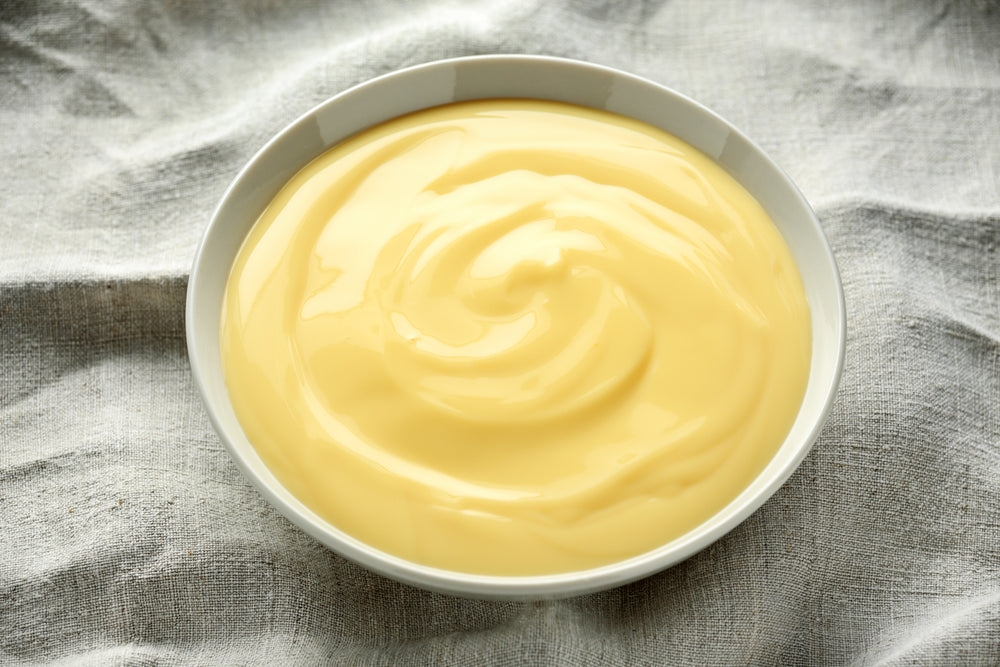People in Britain and in other parts of the world have enjoyed custard for dessert or simply to satisfy their sweet cravings. What began as a simple mixture of egg and cream has now evolved to become a delicious treat that is enjoyed in a variety of flavours, in different ways. Today custard is available in a variety of flavours – vanilla, chocolate, strawberry, blueberry and more. Its journey from a basic recipe to a popular treat around the world shows how much people love and enjoy custard.
Down the Memory Lane
Custard has been a part of the English food since the 17th century. British food history speaks of three main types of custard – créme anglaise, créme pâtissière, and set custards.
- Créme anglaise is also known as cream custard. It is made from egg yolks, cream and vanilla. It has a sauce-like texture.
- Créme pâtissière is a sweet cream used for filling pastries like chocolate éclairs.
- Set custards are baked and set. They are just like similar to a warm, thin ice cream, such as crème brûlée.
Despite its delightful taste consuming traditional custard could be a problem for those with allergies of the egg. It is a common issue and can cause symptoms like asthma, hives, rash and stomach issues from a young age. Since eggs are a key ingredient in custard, people with egg allergies couldn’t enjoy it. But then, a clever English chemist came up with a solution.
Bird Custard Powder: A Creation of Love
Alfred Bird was a British chemist who invented custard powder in 1837. His wife had an egg allergy, which meant she couldn't enjoy traditional custard. To solve this problem Bird created a powder made from corn starch sugar and flavourings that could be mixed with milk to make a creamy custard without eggs. His invention quickly became popular in Britain, providing a convenient and delicious way for everyone to enjoy custard. Over time custard powder became a staple in kitchens around the world making this beloved dessert accessible to all.
Lord Alfred began promoting Bird's Custard Powder throughout the United Kingdom in 1844, and its popularity quickly spread. Bird's Custard became a staple not only in England but also in the British Empire, particularly in Canada, where it is a key ingredient in the famous Nanaimo Bar.
Despite others trying to enter the market, Lord Alfred's sharp business acumen ensured that his name became synonymous with custard powder, driving competitors out of business.
Today, Bird's Custard Powder is owned by Premier Foods. It is a major British food company. They acquired the brand as part of its portfolio and continue to produce and distribute Bird's Custard Powder while maintaining its legacy as a beloved and iconic product in the UK and beyond.
Custard Holds Special Place in Hearts of English

In the UK, custard is prepared in several traditional recipes during special occasions and festivals:
Christmas Trifle: A layered dessert often served during Christmas, trifle includes sponge cake soaked in sherry, fruit, jelly and a generous layer of custard topped with whipped cream.
Bread and Butter Pudding: Commonly enjoyed during the colder months and festive seasons, this dish layers slices of buttered bread with raisins or currants and is baked with a rich custard mixture.
Spotted Dick: A traditional steamed suet pudding containing dried fruit, often served with a warm custard sauce and enjoyed during winter holidays and special gatherings.
Eton Mess: A classic summer dessert made with strawberries, meringue, and custard (or sometimes cream), typically enjoyed at events such as garden parties and summer festivals.
Why is Custard Powder so Popular?
Custard powder is popular for several key reasons:
Convenience: It simplifies the process of making custard. Just mix with milk and heat, and you have a creamy custard without the need for eggs.
Consistency: It ensures a consistent texture and taste in every batch, making it reliable for both home cooks and professional chefs.
Versatility: Custard powder can be used in a variety of recipes, including desserts like trifles, tarts, and pies, as well as sauces and fillings.
Long Shelf Life: It has a long shelf life compared to fresh ingredients, making it a convenient pantry staple.
Cost-Effective: It is often less expensive than using fresh eggs and cream, making it an economical choice for making custard.
Dietary Considerations: It provides an option for those with egg allergies or dietary restrictions, allowing them to enjoy custard without the main allergen.
Reduced Preparation Time: Using custard powder reduces the overall preparation time for custard dishes compared to traditional methods making it a practical choice for quick and efficient cooking.
Custard Powder Flavours
Custard powder is available in a delightful variety of flavours. Here are some popular custard flavours:
Vanilla: The most traditional flavour, made with vanilla extract or vanilla beans. It's smooth and versatile, often used as a base for other desserts.
Chocolate: Rich and indulgent, chocolate custard is made by adding cocoa powder or melted chocolate. It’s a favourite for chocolate lovers.
Butterscotch: This flavour combines the richness of brown sugar and butter, creating a sweet and caramel-like taste in the custard.
Fruit Flavours: Custards can be infused with various fruit flavours, such as strawberry, lemon, or orange. Fruit purées or zest are used to impart vibrant flavours.
Coffee: Coffee custard incorporates brewed coffee or espresso, providing a deep, aromatic flavour that pairs well with chocolate or cream-based desserts.
Spiced: Flavours like cinnamon, nutmeg, or cardamom can be added to custard for a spiced variation, often used in seasonal desserts.
Almond: Almond custard features the nutty flavour of almonds, often enhanced with almond extract or ground almonds.
Caramel: Made with caramel sauce or caramelized sugar, this custard flavour offers a sweet and slightly burnt taste.
Matcha: This custard flavour is made with matcha green tea powder, giving it a distinctive green colour and a subtle, earthy taste.
Coconut: Coconut custard uses coconut milk or shredded coconut, providing a tropical flavour and a creamy texture.
Each flavour adds a unique twist to traditional custard. It is an adaptable dessert suitable for various occasions and personal preferences.


 Christmas 2025
Christmas 2025
 Frozen Food
Frozen Food
 Baking
Baking
 Beans, Peas, Soups & Tins
Beans, Peas, Soups & Tins
 Biscuits, Crackers & Cookies
Biscuits, Crackers & Cookies
 Candy / Sweets
Candy / Sweets
 Crisps & Snacks
Crisps & Snacks
 Chemist / Pharmacy
Chemist / Pharmacy
 Desserts
Desserts
 Gravy, Stock & Paste
Gravy, Stock & Paste
 Haggis
Haggis
 Indian Sauces, Paste and Pickle
Indian Sauces, Paste and Pickle
 Jams & Preserves
Jams & Preserves
 Poppy Appeal
Poppy Appeal
 Pot Noodles & Super Noodles
Pot Noodles & Super Noodles
 Scone Mix
Scone Mix
 Gluten-Free / Free From
Gluten-Free / Free From
 Tea Accessories
Tea Accessories
 Teapot & Tea sets
Teapot & Tea sets
 Tea For One
Tea For One
 Sugar & Creamer
Sugar & Creamer
 Tableware
Tableware
 Serveware
Serveware
 Plates & Trays
Plates & Trays
 Bowls
Bowls
 Cups & Saucers
Cups & Saucers
 Mugs
Mugs
 Silverware
Silverware
 Dinnerware - Accessories
Dinnerware - Accessories
 Dinnerware - For Pets
Dinnerware - For Pets
 Victoria Eggs - Hand-Drawn UK Homeware
Victoria Eggs - Hand-Drawn UK Homeware
 Jewelry & Accessories
Jewelry & Accessories
 Sale
Sale
 Christmas Gifts
Christmas Gifts

